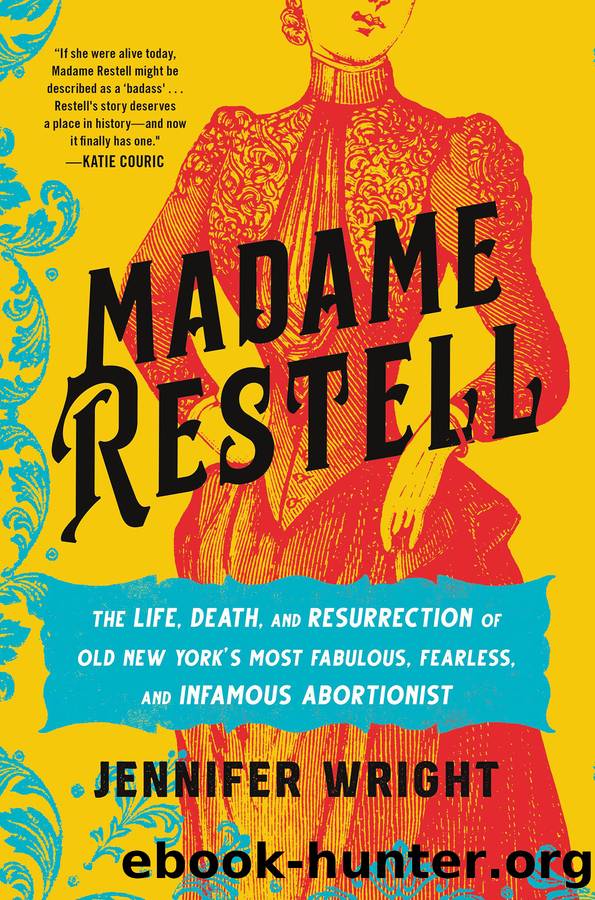Madame Restell by Jennifer Wright

Author:Jennifer Wright [WRIGHT, JENNIFER]
Language: eng
Format: epub
Publisher: Hachette Books
Published: 2023-02-27T00:00:00+00:00
CHAPTER FIFTEEN
BY THE EARLY 1850S, MADAME RESTELL HAD DECIDED SHE would be respectable. Her less-than-flattering portrayal as an elegantly dressed demon in the newspapers was finally starting to bother her. As much as she might have rationalized characterizations in the press as free publicity or dismissed them as the rantings of fools, no one enjoys being called a devil all the time. And so, at least for a few years, Madame Restell began to strive for something she could not bully or charm her way into: social respectability.
She was not alone; it was a decade when many New Yorkers were fighting to improve their reputations. Their thriving metropolis housed over 600,000 people by 1855. Much of the population growth had been due to massive immigration, but city officials hoped to make New York more appealing to the wealthy and cosmopolitan as well. Streets were being widened and railroads installed on the West Side, causing rents to double. Beautiful townhomes were replacing decaying boardinghouses in fashionable parts of the city, causing the New-York Tribune to enthuse that âfrom the old word of Decay flutters forth the gorgeous butterfly of wealth and beauty.â1
There was a new class of people in New York, one chronicled in Charles Astor Bristedâs account, The Upper Ten Thousand, first published in 1852. It perhaps gives the most distinct description of what the elite looked like in New York in that decade. This book was meant to chronicle the behavior of the American upper classes and reassure Europeans that, no matter what they had heard, America was not entirely a land of âsanguinary duels, Lynch law, [Black] babies boiled for breakfast, swamps and yellow fever; in short, a pleasing and promiscuous mess of things horrible and awful.â2
Bristed assured his readers that now, in New York, many men were clad in spotless white outfits, their scarfs held together with diamond pins, their moustaches delicately dyed. Such young New York men, the trust-fund kids of their day, were ârejoicing in nothing to do and ten-thousand a year.â Meanwhile, there were also young women who kept up with all the Parisian fashions and spoke not only proper British English but multiple other European languages. And, no matter what you might have heard, Bristed declared, it was not true that âall our fashionable ladies are in the daily habit of making assignations at the confectioners.â3 Honestly, the fact that he knew that women were not constantly fornicating at candy shops makes him seem more knowledgeable about women than many of his male peers during this period.
Far from being the uncultured hicks wandering around on foot that Europeans might expect, these âUpper Ten Thousandâ were people who had carriages. Bristed makes that crystal clear, through repeated, loving descriptions of their many coaches and horses. For young prospective Gothamites in the Upper Ten Thousand, Bristed advised that the first thing to do âis to get a horse, the second, to get a wife.â4
Perhaps even more important than their carriages, the Upper Ten Thousand were hemmed in by the eraâs continued obsession with respectability.
Download
This site does not store any files on its server. We only index and link to content provided by other sites. Please contact the content providers to delete copyright contents if any and email us, we'll remove relevant links or contents immediately.
| Civilization & Culture | Expeditions & Discoveries |
| Jewish | Maritime History & Piracy |
| Religious | Slavery & Emancipation |
| Women in History |
Cecilia; Or, Memoirs of an Heiress — Volume 1 by Fanny Burney(31321)
Cecilia; Or, Memoirs of an Heiress — Volume 3 by Fanny Burney(30927)
Cecilia; Or, Memoirs of an Heiress — Volume 2 by Fanny Burney(30884)
The Secret History by Donna Tartt(16606)
Sapiens: A Brief History of Humankind by Yuval Noah Harari(13036)
Leonardo da Vinci by Walter Isaacson(11894)
The Radium Girls by Kate Moore(10901)
Sapiens by Yuval Noah Harari(4528)
The Wind in My Hair by Masih Alinejad(4420)
How Democracies Die by Steven Levitsky & Daniel Ziblatt(4392)
Homo Deus: A Brief History of Tomorrow by Yuval Noah Harari(4272)
Endurance: Shackleton's Incredible Voyage by Alfred Lansing(3832)
The Silk Roads by Peter Frankopan(3750)
Man's Search for Meaning by Viktor Frankl(3620)
Millionaire: The Philanderer, Gambler, and Duelist Who Invented Modern Finance by Janet Gleeson(3565)
The Rape of Nanking by Iris Chang(3506)
Hitler in Los Angeles by Steven J. Ross(3429)
The Motorcycle Diaries by Ernesto Che Guevara(3325)
Joan of Arc by Mary Gordon(3252)
